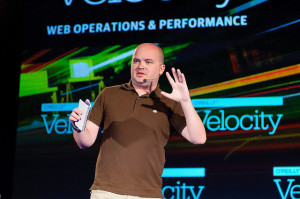If you’re an enterprise digital professional who’s ever marveled at the speed and simplicity of Facebook, Twitter, or Instagram, and wondered why your own web and mobile efforts can’t offer the same performance, this week’s O’Reilly Velocity conference in New York City had some important lessons for you.
Known mostly as a confab where web-scale performance techs compare notes, this year’s Velocity welcomed increasing numbers of traditional enterprises – all of whom realize that their customers expect and demand performance to equal the fastest web scale company.
Web and Mobile Performance: The Buck Stops with the User

For this exceptionally technical crowd, the Velocity audience was surprisingly focused more so on people than on technology: how best to work within teams, how to support the business and its goals, and most importantly, how to improve and optimize the user experience. All the underlying technology, from the back-end systems of record to the web infrastructure to the cloud, all line up to deliver value to the customer on their phone or sitting in front of their computer.
Furthermore, the stakes have never been higher. Today’s web and mobile users are increasingly fickle; a delay of a fraction of a second can lead to abandoned shopping carts, frustrated users, and quick switches to a competitor’s site or mobile app. Improving the speed of the experience, however, is simply the price of admission.
Users also expect increasingly rich, interactive experiences. Today’s Web sites deliver dozens of images, video files, embedded applications, sophisticated ads, and other dynamic content. Even mobile apps participate in an increasingly large and complex ecosystem of other apps and Internet services, and they must all deliver in milliseconds.
Achieving maximum performance thus means pushing increasingly complex technology to its limits. Performance engineers work to squeeze every millisecond out of the technology, which means pushing end-to-end infrastructure to its breaking point. Failure, therefore, is always a single click away.
As a result, performance engineering is more about failure than about speed. For this reason, the primary mission for these teams is resilience.
Read the entire article at http://www.forbes.com/sites/jasonbloomberg/2014/09/18/digital-performance-and-resilience-at-oreilly-velocity/.
At the time of writing, none of the companies mentioned in this report are Intellyx customers. Image credit: O’Reilly Conferences.



